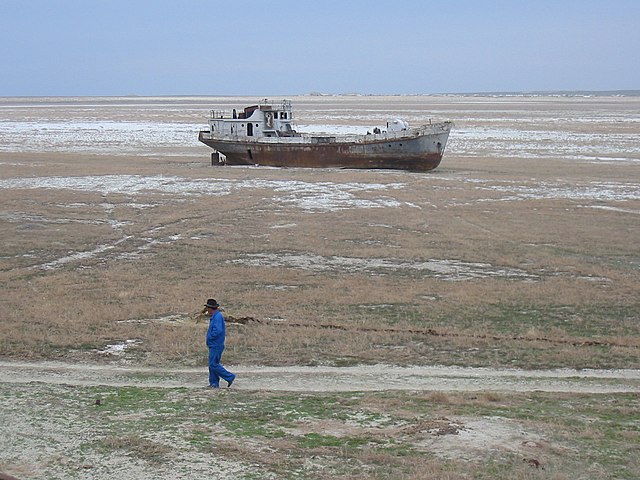
What happened to the Aral Sea? The Soviet Union diverted the rivers that fed it in the 1960s and it has almost completely dried up.
The Aral Sea was located between Kazakhstan in the north and Uzbekistan in the south. It formed between 23 and 2.3 million years ago. It was a fairly shallow lake, but it was the fourth largest lake in the world. The largest lake is the Caspian Sea at 389,000 km2, the second is Lake Huron-Michigan at 117,620 km2, the third lake is Lake Superior at 82,100 km2, and the Aral Sea would have come in fourth at 68,000 km2. The Aral Sea was a water source for all of the communities that lived around it and a source of fish. It was a saltwater body of water, which is why it is called a sea.
The Soviet Union formed in December 1922. The October Revolution of 1917 had overthrown the government and dissolved the Russian Empire. Many of the states that had been part of the Russian Empire became independent. That only lasted for a short time and they were soon swallowed up by the growing Soviet Union. Uzbekistan became part of the Soviet Union in 1924. Kazakhstan became a Soviet republic in 1936. The Soviet Union controlled both countries and all of the land around them, which included the Aral Sea and the rivers that fed it.
The Aral Sea was in an area that is predominantly desert and is very hot. In the summer, temperatures can reach 60℃. Because it is so hot, there was a lot of evaporation from the surface of the Aral Sea. The Aral Sea was fed by the Amu Darya and the Syr Darya, which are two very large rivers. Both of the rivers start in the mountains in the north of Afghanistan and they carried an enormous volume of snowmelt down into the Aral Sea. The volume of the two rivers was enough to offset the amount of evaporation, keeping the lake’s volume fairly constant. The Aral Sea received about 60 km3 of water a year from both of these rivers. The mountains that are the source of the rivers that feed the Aral Sea are also the reason why the whole area is a desert. They block the rain coming up and keep the area arid.
In the 1960s, the Soviet Government, under the leadership of Nikita Khrushchev, decided that they wanted to grow rice, melon, cereals, and cotton on the plains of the desert. In order to do this, they needed water. All of these crops require a large amount of water. It takes roughly 10,000 liters of water to produce 1 kg of cotton. The only source of water available were the Amu Darya and the Syr Darya rivers. The Soviet Government diverted both rivers without considering the consequences. Or, rather more scarily, they did consider the consequences and decided to divert the rivers anyway.
It took a while to divert the rivers, but, by 1980, the Aral Sea was receiving no water from either river and the plains of Uzbekistan were able to produce cotton. Today, Uzbekistan is one of the world’s largest exporters of cotton. The Aral Sea was not receiving the 60 km3 of freshwater a year and it started to evaporate. By 2014, it had shrunk to less than 10% of its original size. As well as that, because it was a saltwater lake, the salinity had become very concentrated and it was 3 times more saline than seawater. Fish cannot survive in water that salty.
The actions of the USSR have had several consequences. The first is the devastation of the communities that lived around the lake. They used the lake for food and for their livelihood. Without it, they have no jobs. The second is pollution. Fertilizers and pesticides used on the land around the lake have ended up in the lake. Then, when the lake vanished, the pollutants became dust on the lakebed that combines with salt and blows onto neighboring fields, making to impossible for the people who live near the lake to grow crops. The climate has changed as well. The lake moderated the temperature. Without it, winters are colder and summers are hotter and drier.
This is a terrible situation, but it is a very clear example of what humans can do. The problem is technically reversible, but then the cotton industry that has grown up in Uzbekistan would be decimated. What is the solution? And this is what I learned today.
Image By User:Staecker – Own work, Public Domain, https://commons.wikimedia.org/w/index.php?curid=658367
Sources
https://en.wikipedia.org/wiki/Geography_of_Afghanistan
https://www.theworldcounts.com/challenges/consumption/clothing/cotton-farming-water-consumption
http://www.columbia.edu/~tmt2120/introduction.htm
https://en.wikipedia.org/wiki/Soviet_Union
https://www.britannica.com/place/Uzbekistan
https://2009-2017.state.gov/outofdate/bgn/kazakhstan/80741.htm
https://en.wikipedia.org/wiki/List_of_lakes_by_area
https://www.britannica.com/place/Aral-Sea
https://en.wikipedia.org/wiki/Aral_Sea
https://earthobservatory.nasa.gov/world-of-change/AralSea

[…] Article: https://ilearnedthistoday.com/index.php/2024/03/02/what-happened-to-the-aral-sea/ […]